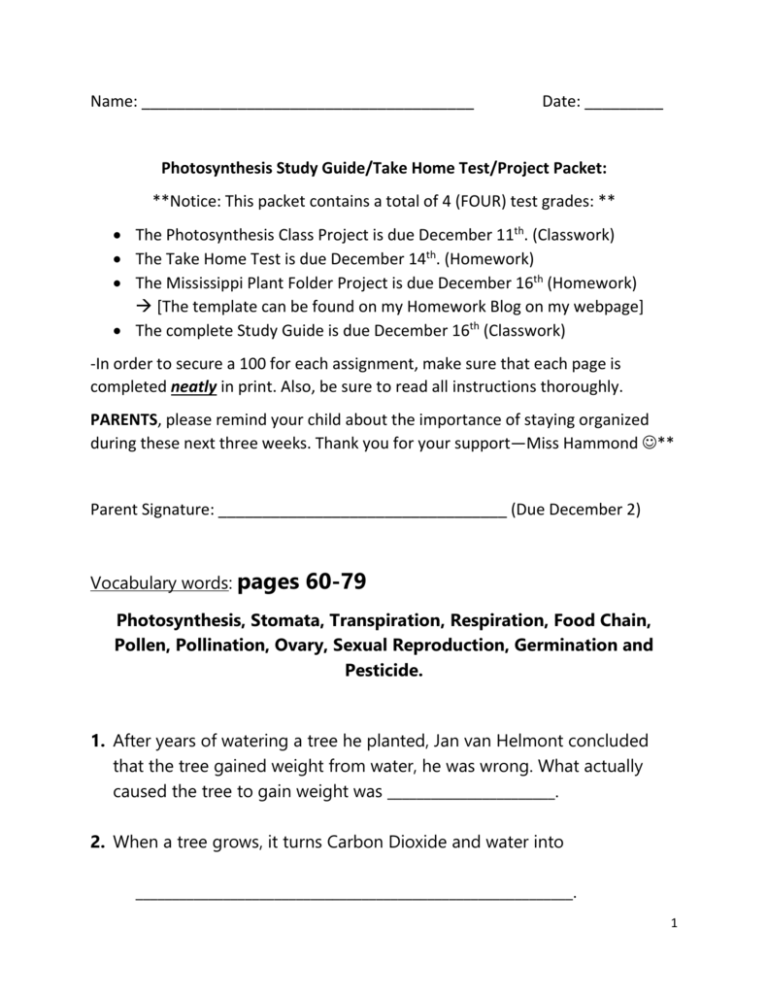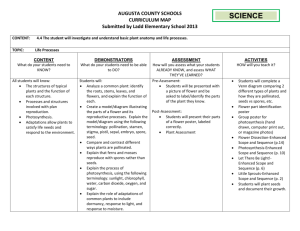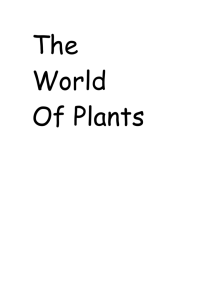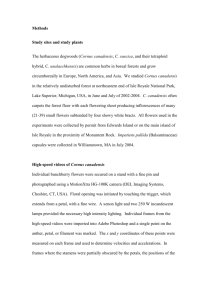Study Guide and Project Template
advertisement

Name: ______________________________________ Date: _________ Photosynthesis Study Guide/Take Home Test/Project Packet: **Notice: This packet contains a total of 4 (FOUR) test grades: ** The Photosynthesis Class Project is due December 11th. (Classwork) The Take Home Test is due December 14th. (Homework) The Mississippi Plant Folder Project is due December 16th (Homework) [The template can be found on my Homework Blog on my webpage] The complete Study Guide is due December 16th (Classwork) -In order to secure a 100 for each assignment, make sure that each page is completed neatly in print. Also, be sure to read all instructions thoroughly. PARENTS, please remind your child about the importance of staying organized during these next three weeks. Thank you for your support—Miss Hammond ** Parent Signature: _________________________________ (Due December 2) Vocabulary words: pages 60-79 Photosynthesis, Stomata, Transpiration, Respiration, Food Chain, Pollen, Pollination, Ovary, Sexual Reproduction, Germination and Pesticide. 1. After years of watering a tree he planted, Jan van Helmont concluded that the tree gained weight from water, he was wrong. What actually caused the tree to gain weight was _______________________. 2. When a tree grows, it turns Carbon Dioxide and water into ____________________________________________________________. 1 3. Photosynthesis is how plants______________ using _________________, Carbon Dioxide, and ___________________. 4. Photosynthesis begins when ______________________ shines on a leaf. The leaf absorbs the light’s _____________________. The energy is used for combining ________________________________________. This produces plant _____________________. Oxygen is a _____________________________. 5. Which gas is produces by the plant? __________________________. 6. Carbon dioxide enters through tiny holes on the outsides of leaves, these tiny holes are called: __________________________. A stoma opens and closes depending on ______________________________________________. 7. Leaves have a think covering called the ___________________________. 8. If a plant has enough water, its stomata ________________________. Water changes to ________________________________ and escapes from the leaves. This process is called ____________________________________. 9. Like all living things, plants need food. They get it from the ___________________ they make during photosynthesis. 10. Veins carry sugars from the leaves to __________________________. The plant breaks down the sugars, this process releases energy and is called _______________________________. 11. During respiration, _______________________ is used to ________________________________________. 2 12. Because plants produce food, plants are called ________________. 13. Animals are called _____________________ because they are organisms that eat other organisms. 14. A _____________________________ shows how energy moves through living things in an environment. 15. There are about _________________ species of plants that make seeds. 16. Plants that make seeds are called __________________. They usually have _______________________________________________. 17. Many seed plants have flowers, they are called ________________ and these plants have fruits. Fruits have seeds inside of them. 18. Other plants have no flowers, they are called _____________________. Pinecones come from nonflowering plants are called _________________. 19. A ___________________ is a seed plant that has no flowers or proof. Pine trees and other conifers have _________________. 20. Most conifer have _______________ and _____________________ cones. Male cones are ________________ than the female cones. 21. The male cones produce _______________ which is a yellow powder. If the pollen lands on a female cone, ______________________________________. 22. The ____________________ is where pollen is made. It is the male part of the flower. 3 23. The _____________________ is where the eggs are made. It is the female part of the flower. 24. To make seeds, pollen must first move from the _________________ to the _________________________. This is also called ________________________. 25. After the pollen sticks to the pistil, the tube grows down to the _____________________, which is a structure that contains eggs. 26. An egg develops into a ____________. An ovary develops into a ______________. 27. As the bird visits another flower, pollen ____________________ the flower and onto the bird’s body. 28. When the bird visits another flower, some of this pollen tubs off on the _______________. The bird is a _______________________________ - an animal that pollinates flowers. 29. Some flowers release an odor, or ___________________, that attracts pollinators. 30. The black oak produces flowers in clusters called _________________. After they release pollen, the catkins fall off of the tree. 31. The underdeveloped plant is called an ________________________, the ________________________ protects the embryo. 4 32. List the steps of germination: 1. __________________________________________________________________________ 2. __________________________________________________________________________ 3. __________________________________________________________________________ 33. A _________________________ is the young plant that grows from a seed it needs water, light and nutrients to grow. 34. What is sexual reproduction according to the book? ________________________________________________________________________________ 35. _______________________________ occurs when a sperm cell combines with a female sex cell—the egg. 36. A ________________________ is a substance used to kill pests or unwanted animals. Math Link: A tree produces 3,000 seeds. Squirrels bury half of the seeds. In winter, the squirrels find and eat half of the seeds they buried. How many seeds are left underground? Show your work. ___________________________________________________________________ 5 Scientist: Experiment: What we learned: Helmont: Priestly: 6 7 Name: ____________________________ Date: ____________ Group Photosynthesis Project: (In Class Assignment) Due: December 11th **Instructions: In your group, make a poster showing photosynthesis and respiration. Make sure to label the roots, leaves, sunlight, oxygen and carbon dioxide (Hint: include arrows showing which direction Oxygen and Carbon Dioxide flow). Be prepared to present to the class. Group Name: ___________________________ Which plant did your group choose? : ____________________________ Group Members: ____________________________________________________. Grading Rubric (How the group will be graded): -The teacher will grade the group based on completion the following topics. Are all the team members listed on the back of the project? ____/10points Did everyone bring their study guide on December 11th? ______/10 points Did the project have each part labeled? : Roots, leaves, sunlight, oxygen, carbon dioxide and arrows? _________/15 Was the group prepared to present to the group? ________/5 Did the group create a project that caught the audience’s attention? ___/10 Total Points: _____/50 8 Name: _______________________ Date: _____________ Mississippi Plant Book Project: (Homework Assignment) Due: December 16th **Instructions: Create a picture book about 10 (or more) different plants that can be found in Mississippi. ** Rubric (How the student will be graded): Was the assignment in a folder with brads or small binder? _____/5 points Did the assignment have a cover page with the student’s name, the date and Mississippi Plant Book Project in the center of the first page? ____/5 points Did the student find and list 10 (or more) different types of plants grown in Mississippi? ______/30 points Did the student provide a picture or drawing of each of the plants that were chosen? ______/15 points Did the student provide the Latin name of each plant chosen? ___/10 points Did the student write neatly or type at least 3 facts about each plant that were chosen? _____/25 points Is the project typed or written neatly? ________/15 points Total Points: _________/ 105 points 9 Name: ____________________________ Date: __________________ Mississippi Plate Book Project Template: Names of plant: 10











